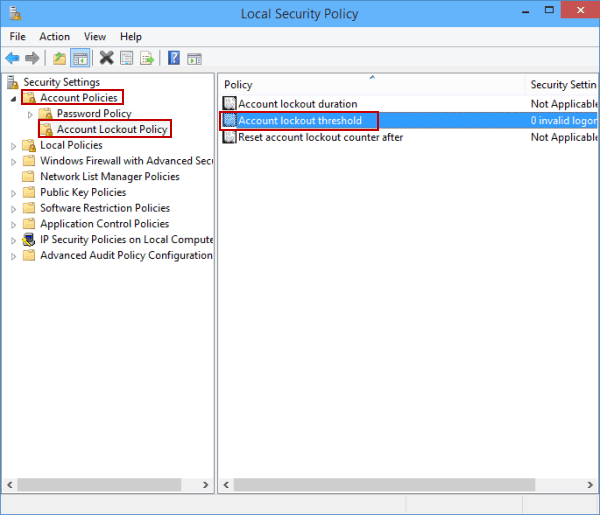

- #ACCOUNT LOCKOUT TOOLS SERVER 2012 R2 UPDATE#
- #ACCOUNT LOCKOUT TOOLS SERVER 2012 R2 PASSWORD#
- #ACCOUNT LOCKOUT TOOLS SERVER 2012 R2 WINDOWS 7#
- #ACCOUNT LOCKOUT TOOLS SERVER 2012 R2 DOWNLOAD#
- #ACCOUNT LOCKOUT TOOLS SERVER 2012 R2 WINDOWS#
#ACCOUNT LOCKOUT TOOLS SERVER 2012 R2 WINDOWS#
The MANIFEST files (.manifest) and the MUM files (.mum) that are installed for each environment are listed separately in the "Additional file information for Windows Server 2008 R2" section. The files that apply to a specific product, SR_Level (RTM, SP n), and service branch (LDR, GDR) can be identified by examining the file version numbers as shown in the following table. Always refer to the "Applies To" section in articles to determine the actual operating system that each hotfix applies to. To request the hotfix package that applies to one or both operating systems, select the hotfix that is listed under "Windows 7/Windows Server 2008 R2" on the page. However, hotfixes on the Hotfix Request page are listed under both operating systems.
#ACCOUNT LOCKOUT TOOLS SERVER 2012 R2 WINDOWS 7#
Windows Server 2008 R2 file information notesImportant Windows 7 hotfixes and Windows Server 2008 R2 hotfixes are included in the same packages. To find the difference between UTC and local time, use the Time Zone tab in the Date and Time item in Control Panel. When you view the file information, it is converted to local time. The dates and times for these files are listed in Coordinated Universal Time (UTC). The English version of this hotfix has the file attributes (or later file attributes) that are listed in the following table. This hotfix does not replace any previously released hotfix. You must restart the computer after you apply this hotfix. You must have Windows Server 2008 R2 Service Pack 1 installed to apply this hotfix. If you do not see your language, it is because a hotfix is not available for that language.
#ACCOUNT LOCKOUT TOOLS SERVER 2012 R2 DOWNLOAD#
The "Hotfix download available" form displays the languages for which the hotfix is available. For a complete list of Microsoft Customer Service and Support telephone numbers or to create a separate service request, go to the following Microsoft website: The usual support costs will apply to additional support questions and issues that do not qualify for this specific hotfix. Note If additional issues occur or if any troubleshooting is required, you might have to create a separate service request. If this section does not appear, contact Microsoft Customer Service and Support to obtain the hotfix. If the hotfix is available for download, there is a "Hotfix download available" section at the top of this Knowledge Base article.
#ACCOUNT LOCKOUT TOOLS SERVER 2012 R2 UPDATE#
Therefore, if you are not severely affected by this problem, we recommend that you wait for the next software update that contains this hotfix. This hotfix might receive additional testing. Apply this hotfix only to systems that are experiencing the problem described in this article. However, this hotfix is intended to correct only the problem that is described in this article. However, expected behavior is that the NPS server locks the user for a specific time after the number of tries that are set in the MaxDenials entry to prevent the user account lockout.Ī supported hotfix is available from Microsoft. In this scenario, the user might be locked out from the Active Directory domain controller before he or she is locked out on the NPS server. There are small communication latencies between the computer that is running NPS and the Active Directory domain controller.
#ACCOUNT LOCKOUT TOOLS SERVER 2012 R2 PASSWORD#
The password of a user expires, and the user changes the password on their desktop computer.ĭevices such as mobile phones or tablets try to authenticate with the server repeatedly by using the old password quickly. You set the Active Directory account lockout policy for wrong passwords to 4. You enable remote access account lockout and set the MaxDenials entry to 3. You configure a Windows Server 2008 R2-based computer that is running Network Policy Server (NPS) as the Remote Authentication Dial-In User Service (RADIUS) server to perform authentication for RADIUS clients.

Windows Server 2008 R2 Datacenter Windows Server 2008 R2 Enterprise Windows Server 2008 R2 for Itanium-Based Systems Windows Server 2008 R2 Foundation Windows Server 2008 R2 Standard More.


 0 kommentar(er)
0 kommentar(er)
